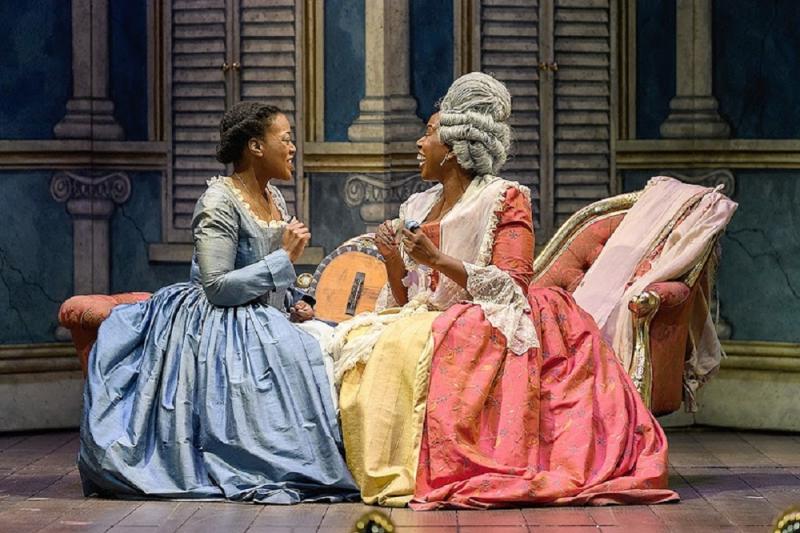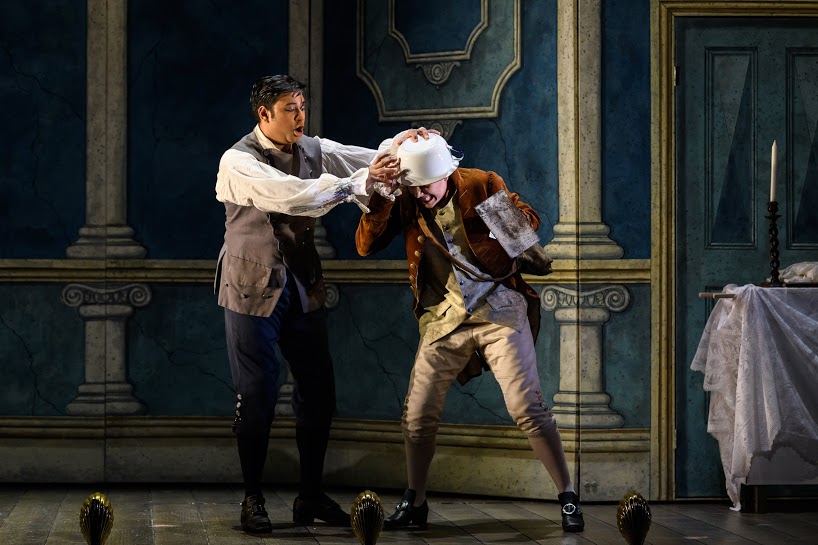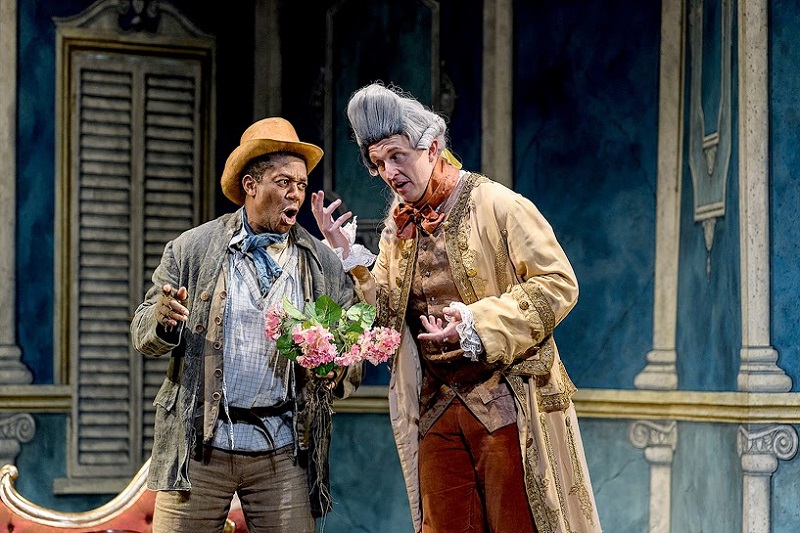The Marriage of Figaro, English Touring Opera review - vanilla Mozart still tastes sweet | reviews, news & interviews
The Marriage of Figaro, English Touring Opera review - vanilla Mozart still tastes sweet
The Marriage of Figaro, English Touring Opera review - vanilla Mozart still tastes sweet
Strong ensemble and basic staging help Mozart and Da Ponte succeed without tricks

The Fates did not want theartsdesk to review English Touring Opera’s new production of The Marriage of Figaro.
Does that matter? It needs to be asked, because Mozart and Da Ponte’s comic opera is so perfectly weighted, so lightly and exquisitely sprung, that every note counts. It’s often possible to tell whether a performance of The Marriage of Figaro is going to fly or flop before the end of the overture, and the way Figaro and Susanna respond to each other in the first minutes after the curtain goes up can seal the deal. And yet these characters are so engaging and the world Mozart and Da Ponte create is so real that however late you arrive, as a rule you’re just glad to be there. All opinions that follow, however, come with the qualification that one piece of the jigsaw might be missing.
And of course, it wasn’t strictly speaking Se vuol ballare that I interrupted – the production was sung in English, in Jeremy Sams’s boisterous rhyming couplets. That’s usually a sound decision in a comedy, and with the cast projecting clearly and audibly (judging from seats in the back and front stalls, anyway), the jokes landed and the cast was able to play off the laughter of a capacity audience. Which is just as well, because – without doing anything that would startle traditionalists – director Blanche McIntyre plays the piece principally for laughs. Costumes are standard issue 1780s, with just the merest hint of the surreal. Count Almaviva’s outsize peruke suggests a coxcomb in more ways than one, while Neil Irish’s flat, folding interior set designs have the air, if not of a cartoon exactly, then certainly of illustrations in a children’s book.
That makes an appropriate setting for a cast that’s been chosen for stage presence and ensemble rapport rather than megawatt voices. This was Figaro as a chamber piece, without a chorus but with a full orchestra which, under Christopher Stark, played with style and warmth at tempos that made the drama glow rather than fizz. McIntyre’s direction, too, was leisurely. In Acts One and Two we saw rather a lot of characters standing about and metaphorically twiddling their thumbs (the Countess - played by Nadine Benjamin, pictured above - simply positioned herself behind her chaise longue and delivered "Porgi amor" straight at the audience), though things seemed to pull more sharply into focus after the interval.
Which is not to say that there wasn’t some deft characterisation throughout. Ramgobin (pictured below, left) demonstrated his comic chops in entertainingly louche style in last season’s Patience: his Figaro was a cheerful, up-for-it Jack the Lad, whose knowing shrugs and raised eyebrows drolly filled out the persona sketched by his pleasant light baritone. He delivered his recitatives with delicious comic timing, over some sparky continuo playing, and hit the deck and started doing push-ups during "Non piu andrai". As Susanna, Rachel Redmond stopped just short of running away (as Susannas sometimes can) with the whole show. Her sunny, chiming coloratura and graceful phrasing complemented an affectionate performance.  And as with all the best Figaro ensembles, the central pair illuminated and reflected the characters around them. Dawid Kimberg’s (pictured below, right) ramrod straight Count (his roaming hands were the only uncontrolled thing about him) seemed even more unbending and vocally chilly besides this Figaro, while next to Redmond’s lightly worn vocal poise, Benjamin’s creamy tone acquired a noticeably fraught edge at moments of emotional pressure. It was a nice touch to have a Cherubino (Katherine Aitken, pictured above) who was every bit as gangly and cocksure as his master, and practically luxury casting to have Gaynor Keeble as a determinedly youthful and flirtatious Marcellina – one whose voice blended so sweetly with Redmond’s that the notion that both women might be serious contenders for Figaro’s hand seemed, for once, almost plausible.
And as with all the best Figaro ensembles, the central pair illuminated and reflected the characters around them. Dawid Kimberg’s (pictured below, right) ramrod straight Count (his roaming hands were the only uncontrolled thing about him) seemed even more unbending and vocally chilly besides this Figaro, while next to Redmond’s lightly worn vocal poise, Benjamin’s creamy tone acquired a noticeably fraught edge at moments of emotional pressure. It was a nice touch to have a Cherubino (Katherine Aitken, pictured above) who was every bit as gangly and cocksure as his master, and practically luxury casting to have Gaynor Keeble as a determinedly youthful and flirtatious Marcellina – one whose voice blended so sweetly with Redmond’s that the notion that both women might be serious contenders for Figaro’s hand seemed, for once, almost plausible. That’s essentially it. There were no tricks; the alarums and excursions in Act Four’s nocturnal garden played out clearly and amusingly; the character roles – most notably Devon Harrison’s bluff cockney Antonio (pictured above, left), and Abigail Kelly as a Barbarina who was nobody’s wide eyed innocent – were sharply drawn. And at that sublime moment in Act Four where the Countess steps forward to forgive and Mozart’s score brims over with compassion, I felt that all-important pricking behind the eyes: the unfailing indicator that a Figaro has hit its mark. There are bigger, starrier and more complex stagings out there: productions that are faster, sassier and considerably darker. But it’s useful to be reminded that a straightforward vanilla Marriage of Figaro, performed with wit and a good heart, is still pretty much the best night out you could possibly hope for.
That’s essentially it. There were no tricks; the alarums and excursions in Act Four’s nocturnal garden played out clearly and amusingly; the character roles – most notably Devon Harrison’s bluff cockney Antonio (pictured above, left), and Abigail Kelly as a Barbarina who was nobody’s wide eyed innocent – were sharply drawn. And at that sublime moment in Act Four where the Countess steps forward to forgive and Mozart’s score brims over with compassion, I felt that all-important pricking behind the eyes: the unfailing indicator that a Figaro has hit its mark. There are bigger, starrier and more complex stagings out there: productions that are faster, sassier and considerably darker. But it’s useful to be reminded that a straightforward vanilla Marriage of Figaro, performed with wit and a good heart, is still pretty much the best night out you could possibly hope for.
rating
Explore topics
Share this article
The future of Arts Journalism
You can stop theartsdesk.com closing!
We urgently need financing to survive. Our fundraising drive has thus far raised £49,000 but we need to reach £100,000 or we will be forced to close. Please contribute here: https://gofund.me/c3f6033d
And if you can forward this information to anyone who might assist, we’d be grateful.

Subscribe to theartsdesk.com
Thank you for continuing to read our work on theartsdesk.com. For unlimited access to every article in its entirety, including our archive of more than 15,000 pieces, we're asking for £5 per month or £40 per year. We feel it's a very good deal, and hope you do too.
To take a subscription now simply click here.
And if you're looking for that extra gift for a friend or family member, why not treat them to a theartsdesk.com gift subscription?
more Opera
 Albert Herring, English National Opera review - a great comedy with depths fully realised
Britten’s delight was never made for the Coliseum, but it works on its first outing there
Albert Herring, English National Opera review - a great comedy with depths fully realised
Britten’s delight was never made for the Coliseum, but it works on its first outing there
 Carmen, English National Opera review - not quite dangerous
Hopes for Niamh O’Sullivan only partly fulfilled, though much good singing throughout
Carmen, English National Opera review - not quite dangerous
Hopes for Niamh O’Sullivan only partly fulfilled, though much good singing throughout
 Giustino, Linbury Theatre review - a stylish account of a slight opera
Gods, mortals and monsters do battle in Handel's charming drama
Giustino, Linbury Theatre review - a stylish account of a slight opera
Gods, mortals and monsters do battle in Handel's charming drama
 Susanna, Opera North review - hybrid staging of a Handel oratorio
Dance and signing complement outstanding singing in a story of virtue rewarded
Susanna, Opera North review - hybrid staging of a Handel oratorio
Dance and signing complement outstanding singing in a story of virtue rewarded
 Ariodante, Opéra Garnier, Paris review - a blast of Baroque beauty
A near-perfect night at the opera
Ariodante, Opéra Garnier, Paris review - a blast of Baroque beauty
A near-perfect night at the opera
 Cinderella/La Cenerentola, English National Opera review - the truth behind the tinsel
Appealing performances cut through hyperactive stagecraft
Cinderella/La Cenerentola, English National Opera review - the truth behind the tinsel
Appealing performances cut through hyperactive stagecraft
 Tosca, Royal Opera review - Ailyn Pérez steps in as the most vivid of divas
Jakub Hrůša’s multicoloured Puccini last night found a soprano to match
Tosca, Royal Opera review - Ailyn Pérez steps in as the most vivid of divas
Jakub Hrůša’s multicoloured Puccini last night found a soprano to match
 Tosca, Welsh National Opera review - a great company reduced to brilliance
The old warhorse made special by the basics
Tosca, Welsh National Opera review - a great company reduced to brilliance
The old warhorse made special by the basics
 BBC Proms: The Marriage of Figaro, Glyndebourne Festival review - merriment and menace
Strong Proms transfer for a robust and affecting show
BBC Proms: The Marriage of Figaro, Glyndebourne Festival review - merriment and menace
Strong Proms transfer for a robust and affecting show
 BBC Proms: Suor Angelica, LSO, Pappano review - earthly passion, heavenly grief
A Sister to remember blesses Puccini's convent tragedy
BBC Proms: Suor Angelica, LSO, Pappano review - earthly passion, heavenly grief
A Sister to remember blesses Puccini's convent tragedy
 Orpheus and Eurydice, Opera Queensland/SCO, Edinburgh International Festival 2025 review - dazzling, but distracting
Eye-popping acrobatics don’t always assist in Gluck’s quest for operatic truth
Orpheus and Eurydice, Opera Queensland/SCO, Edinburgh International Festival 2025 review - dazzling, but distracting
Eye-popping acrobatics don’t always assist in Gluck’s quest for operatic truth
 MARS, Irish National Opera review - silly space oddity with fun stretches
Cast, orchestra and production give Jennifer Walshe’s bold collage their all
MARS, Irish National Opera review - silly space oddity with fun stretches
Cast, orchestra and production give Jennifer Walshe’s bold collage their all

Add comment